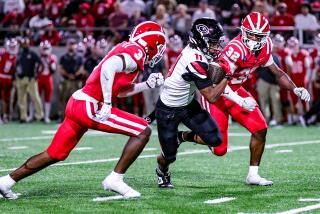Using their brains
Stanford’s two top running backs? Members of the National Honor Society.
One of its primary receivers? A high-school all-academic, now working on his master’s degree in political science.
The Cardinal offensive line? Everyone was on a high school honor roll. One is now a classics major. Another is working on his bachelor’s in science, technology and society while getting a master’s in sociology.
This is the team that upset USC on Saturday.
During the game, I counted 66 kids in Cardinal red and white. In their media guide, more than half -- 36 -- were listed in the National Honor Society. More than a dozen were Merit Scholars in high school. Ten are now academic All-Pacific 10 Conference. Eight are studying for advanced degrees.
Sure, beating USC made them winners -- but the truth is, they are double winners: on the field, and in the classroom.
The Trojans -- indeed the entire Pac-10 and almost all major college football teams -- can learn from Stanford. They can learn what college ought to be about: education.
Stanford footballers, brace yourself, are first and foremost students. Not just good students, but great ones.
Imagine that.
It starts with the kind of football players Stanford recruits. It might make for some long, ugly dry spells, but almost all Cardinal recruits are kids whose greatest successes come in the classroom.
Let’s say a kid is an all-everything tailback with a C average and low but acceptable College Board scores. Big-time coaches will sit down with his parents and offer the world. Trust me, a kid like that will find a home at Iowa, Florida or USC.
Stanford won’t bother.
What if the same kid has a B-plus average and better-than-average College Board scores?
Stanford still might not look his way.
“We hired a new admissions director when I was there, and even though the standard was always rough, they started coming down really, really hard,” says former Cardinal quarterback Chris Lewis, a 2004 graduate who threw for 390 yards against California in the Big Game. “Guys who had 3.65 GPAs and 1200 on the SATs, they could go almost anywhere else. They were getting turned down just because they were not absolute straight-A students.
“That’s pretty frustrating,” Lewis adds, “when you’re having some down years.”
Out of about 3,000 high school players good enough for college ball, only about “400 would qualify to come here,” says Bob Bowlsby, Stanford’s athletic director. Of those, Stanford gets only a few. Many are talented enough to have their pick of other schools, where winning comes far more steadily.
Bowlsby won’t talk about whether requirements have tightened up. But he concedes that holding on to extremely high academic standards makes it very tough to win consistently.
Then, once recruits step on campus, they are expected to keep up their academic performance -- in fact, improve.
Recently a busload of USC athletes were found trying to pump up their grades by taking a class at Los Angeles Trade Tech College that was later discredited. That’s not happening in Palo Alto. Cardinal players don’t take Underwater Fire Prevention. This year, Stanford has 15 players majoring in engineering. They cannot take an easy coarse load. There isn’t any.
Moreover, Cardinal football players are almost certain to leave Palo Alto with diplomas. A study released last week by the NCAA, which tracked freshmen who entered college from 1997 to 2000, shows that 93% at Stanford graduate.
At USC, it’s 57%.
At UCLA, 56%.
I went to Cal, which calls itself the finest public university in the land. I co-captained a tennis team that won a national indoor title. When I looked at the NCAA study and zoomed in on my alma mater, I felt an urge to lose my lunch. Cal might have become a football power, but at what cost?
Its graduation rate for football players? Just over 52%.
Sad.
Not every school needs to be as strict as Stanford. Some kids deserve a second chance at taking education seriously. But graduating only half of the athletes on a major-college football team is a scam.
“The reality of college football is that it is big business,” says Richard Lapchick, director of the Institute for Diversity and Ethics in Sport at the University of Central Florida. He has made a career out of studying this stuff. Too often, he says, kids are brought in “more for their ability to score touchdowns than to get engineering degrees. Do these schools need to do a better job? Absolutely.”
Crucial to Stanford’s 24-23 victory were four interceptions by stealthy Cardinal defensive backs. One errant Trojans pass was picked off by a high school valedictorian. Another came courtesy of a kid who was an academic all-state nominee in Utah in high school. A third landed in the hands of a National Honor Society member.
Perhaps the most significant interception came courtesy of Austin Yancy, who ran a John David Booty pass back for a touchdown. Was Yancy in the Honor Society too?
You bet . . . and a member of the Spanish Honor Society . . . and listed in Who’s Who Among American High School Students . . . and his school’s representative at Boys State, a political leadership training program.
Four interceptions. Four defenders. Four kids -- and an entire team -- that we should feel good about because they do it right.
--
More to Read
Go beyond the scoreboard
Get the latest on L.A.'s teams in the daily Sports Report newsletter.
You may occasionally receive promotional content from the Los Angeles Times.







